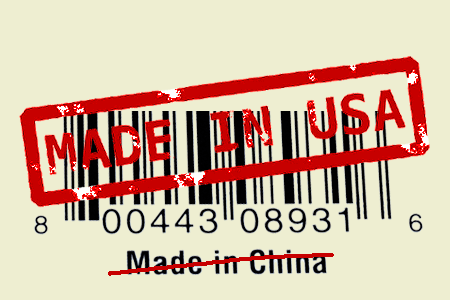US Manufacturers ‘Reshoring’ From China
Recent examples of companies announcing plans to shift production from China to the US include K’Nex, the toy manufacturer, Trellis Earth Products, which makes bioplastic goods such as bags and utensils, and Handful, the bra manufacturer.
The Boston Consulting Group survey found 21 per cent of a sample of 200 executives of large manufacturers were either already relocating production to the US, or planning to do so within the next two years. A further 33 per cent said they were considering it, or would consider it in the near future.
Those figures are sharply increased from a similar BCG survey early last year, which found 10 per cent of respondents moving production to the US, and a further 27 per cent considering or close to considering it.
Labour costs were the factor most commonly cited by executives as determining location decisions, and China’s advantage has been slipping. Wage inflation has been running at about 15-20 per cent per year. Average hourly earnings in US manufacturing have risen just 1.6 per cent per year since 2011.
So far there has been little sign in the employment data of the improvement in the competitive position of US manufacturing. After bouncing back strongly from the trough of the recession, US manufacturing employment has stagnated for the past year at just under 12m.
However, Hal Sirkin of BCG said he expected the effect of reshoring would begin to show in the data over the next few years.
“These are leading indicators,” he said. “If you are going to have a plant up and running in 2015, you have to start planning in 2011, or 2012 at the latest.”
BCG is predicting that, by the end of the decade, reshoring and rising exports will have created 0.6m-1.2m new manufacturing jobs in the US.
The effect will vary across industries, BCG says. Prime candidates for reshoring are industries that have relatively lower labour costs, and relatively higher transport costs or other reasons to be close to their customers.
The US shale boom is also stimulating investment in industries that have high energy costs, particularly petrochemical production.



Reshoring, producing more of what we consume, is a key element in solving our nation’s economic problems.
U.S.’ biggest advantage is being the world’s largest market. Our goal is to make 90% of what we consume instead of 75%. If we do that, we will stay the largest market for many years and thus offer companies an intrinsic advantage to manufacture here.
Manufacturing has the highest multiplier effect of any economic sector based on data from the Bureau of Economic Analysis.
The positive effects of a healthy industrial sector spread far beyond manufacturing itself.
Reports from the National Association of Manufacturing (NAM) indicate every dollar that’s created in manufacturing, has a 1.4 multiplier effect on the entire economy.
Growth in manufacturing therefore fuels other sectors, creating jobs and investment in non-manufacturing sectors.
Current research shows many companies can reshore about 25% of what they have offshored and improve their profitability if they used TCO instead of price to make their decision.
The not-for-profit Reshoring Initiative offers a free Total Cost of Ownership software that helps corporations calculate the real P&L impact of reshoring or offshoring. In many cases companies will find that, although the production cost is lower offshore, the total cost is higher. TCO Estimator http://www.reshorenow.org/TCO_Estimator.cfm
You can reach Harry Moser, founder/president of The Reshoring Initiative, at harry.moser@reshorenow.org | http://www.reshorenow.org
Read ReMaking America AAM’s new book on how manufacturing may see a new dawn in America along with wealth and growth opportunities. http://americanmanufacturing.org/remake-america/ Harry Moser wrote the chapter on Reshoring.